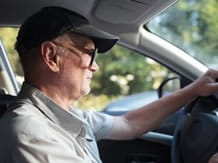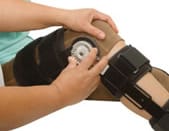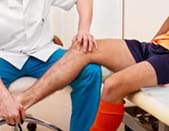In today’s world, going about your day-to-day business without a car is almost impossible. But in our ageing society, it’s important to ask at what age a person becomes a danger to themselves and others on the road? And does osteoarthritis make a difference?

One of the keys to safe driving is the driver’s ability to stop within a given time. There are two factors that effect the distance travelled by a car during emergency braking1: the braking distance, which is getting shorter as cars become more advanced, and the reaction distance, that is, the distance travelled by the car before the driver reacts and activates the braking system. Reaction distance can be affected by lots of things, including alcohol consumption and the use of mobile phones2. Some researchers decided to investigate whether lower-limb osteoarthritis was one of these factors3.
Using a simulator, the researchers studied the influence of osteoarthritis of the knee (which affects between 12% and 16% of adults aged 45 and over4.5) and the hip (around 10%6) on the reaction distance. On average, people with osteoarthritis did not exceed the limits set by the competent authorities7.8 to guarantee safe braking (700 ms to 1500 ms depending on the urgency with which they need to brake). Nevertheless, osteoarthritis of the knee (left and right) and the right hip significantly increased reaction times: for a vehicle travelling at 100 kmh, the braking distance increased by three to four metres compared with a driver without osteoarthritis. This difference could cause a collision, although this is only an average: some people with osteoarthritis far exceed the 700 ms threshold.
Sources :
1. Green M: How long does it take to stop? Methodological analysis of driver perception-brake times. Transport Human Factors 2000, 2:195-216.
2. Rafaelsen OJ., Bech P., Rafaelsen L., Simulated car driving influenced by cannabis and alcohol. Pharmakopsychiatr Neuropsychopharmakol 1973, 6(2):71-83.
3. Hofmann U.K. et coll. : Osteoarthritis of the knee or hip significantly impairs driving ability (cross-sectional survey). BMC Musculoskeletal Disorders 2014, 15: 20. doi:10.1186/1471-2474-15-20.
4. Dillon CF, Rasch EK, Gu Q, Hirsch R: Prevalence of knee osteoarthritis in the United States: arthritis data from the Third National Health and Nutrition Examination Survey 1991-94. J Rheumatol 2006, 33(11):2271-2279.
5. Jordan JM, Helmick CG, Renner JB, Luta G, Dragomir AD, Woodard J, Fang F, Schwartz TA, Abbate LM, Callahan LF, et al.: Prevalence of knee symptoms and radiographic and symptomatic knee osteoarthritis in African Americans and Caucasians: the Johnston County Osteoarthritis Project.nJ Rheumatol 2007, 34(1):172-180.
6. Jordan JM, Helmick CG, Renner JB, Luta G, Dragomir AD, Woodard J, Fang F, Schwartz TA, Nelson AE, Abbate LM, et al.: Prevalence of hip symptoms and radiographic and symptomatic hip osteoarthritis in African Americans and Caucasians: the Johnston County Osteoarthritis Project. J Rheumatol 2009, 36(4):809-815.
7. OIDoT: The Highway Code. United Kingdom: Her Majesty’s Stationary Office; 1978. 8. Victoria RAC: Average Reaction, Braking and Stopping Distances in Metres at Different Speed with Reaction Time of 0.75 Seconds. Melbourne, Australia: Royal Automobile Club of Victoria; 1996.






















